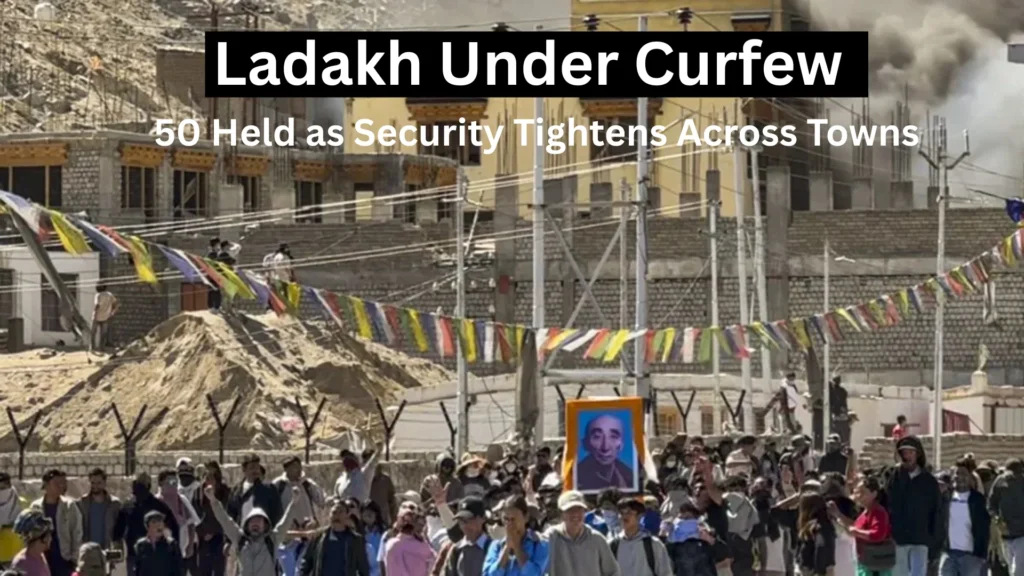
Ladakh’s Leh region is under a strict curfew after severe violence erupted during statehood protests, resulting in four deaths, dozens of injuries, and at least 50 arrests. Security forces have tightened their presence across key towns as authorities scramble to restore peace in the aftermath of the worst unrest in decades.
Curfew Imposed After Deadly Clashes
After a wave of violence swept through Leh, authorities enforced a comprehensive curfew on Thursday to contain further unrest. These measures came in response to widespread street clashes, arson, and targeted attacks against government and political offices. Police resorted to firing and teargas to disperse crowds, as nearly 80 people—including more than 30 police personnel—were injured during the upheaval, and four people lost their lives. Additional paramilitary units have been called in to patrol sensitive locations, and Section 163 of the BNSS has been invoked, banning all public rallies without pre-approval.
Trigger: Hunger Strike and Growing Anger
The immediate trigger for this violence was the critical hospitalization of two elderly hunger strikers, Tsering Angchuk and Tashi Dolma, who had joined 13 others in a prolonged 35-day hunger strike demanding statehood and Sixth Schedule constitutional protection for Ladakh. Outrage over their deteriorating condition galvanized youth across the region, sparking street protests that quickly escalated into violence. Leading climate activist Sonam Wangchuk, whose peaceful movement was derailed by the unrest, subsequently called off his hunger strike and appealed for calm.
Protesters’ Demands: Statehood and Sixth Schedule
The protesters, organized by groups like the Leh Apex Body and the Kargil Democratic Alliance, have long demanded that Ladakh be granted statehood and be brought under the protective provisions of the Sixth Schedule of the Constitution—usually reserved for certain tribal regions in northeast India. These measures, they argue, are essential to safeguard Ladakh’s environment, local identity, and political rights, all of which they feel have been neglected since the region’s reorganization in 2019.
Government Response and Crackdown
The government has accused protest leaders, especially Sonam Wangchuk, of inciting violence through provocative speeches during the hunger strike. Authorities quickly imposed a district-wide curfew and launched a crackdown, detaining at least 50 protestors and promising stringent action against those identified as responsible for the violence and arson. The Lt Governor of Ladakh, Kavinder Gupta, condemned the violence and extended condolences to families of the deceased, promising all necessary measures to prevent further incidents.
The Road Ahead: Dialogue and Tension
With the curfew firmly in place, the situation in Ladakh remains tense and uncertain. Reinforcements from the CRPF and local security agencies have secured major towns, while hospitals continue to treat the critically injured. Civil society groups and national leaders are urging calm and renewed dialogue between the Centre and Ladakh’s leaders to prevent any further loss of life and resolve the ongoing statehood impasse.
As Leh recovers from this unprecedented turmoil, the demands for political empowerment and protection for Ladakh’s people remain at the heart of a movement fraught with pain and hope.
Read Other Blog Posts- Click Here
- Thanksgiving 2025 – Celebrating Togetherness & Blessings
- Tata Motors Demerger Commercial Vehicles Business – Share Listed
- Bihar Elections Exit Polls 2025: Trends, Predictions & Implications
- SEBI Warning Sparks Concern: Is Your Digital Gold Investment Safe?
- Groww IPO Day 3 Live: ₹6,632 Crore Issue Closes Today — Check Price Band, GMP, Allotment Date, Valuation & More
